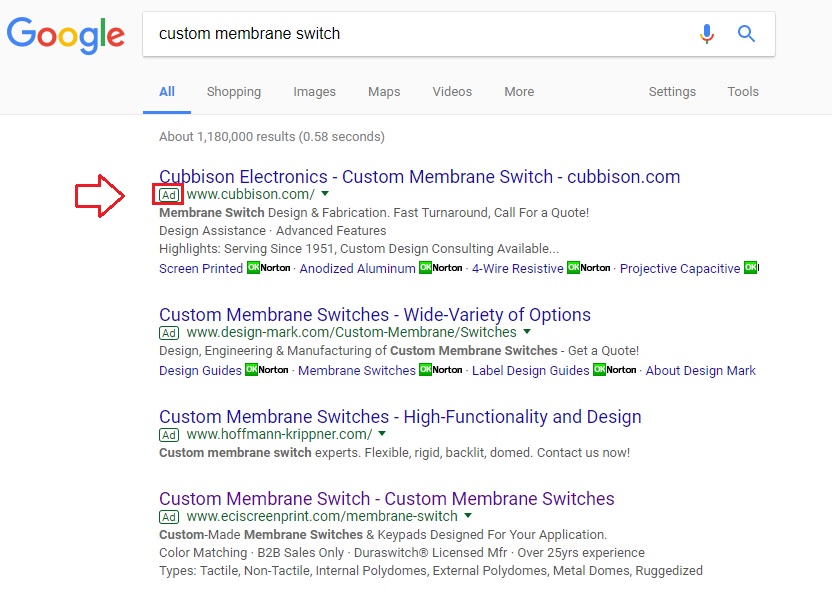For those new to search engine marketing, Google positions paid ads in the top four spots of their search results (see screenshot below). Sometimes, when our clients search their keywords and find their ads showing up second or third instead of first, we get the call asking: “What determines the placement of my Google search ads?”
Many people assume that the top spot on Google’s search results is simply given to the highest bidder. While bidding is part of the ad positioning equation, there are a few other variables involved as well. All of these variables fall under the category of what’s known as Quality Score – Google’s rating of the quality and relevance of your ads.
To calculate your Quality Score, Google examines the text in your ads, your landing pages, the keywords in your ad groups, your CTR (click-through-rate), and your AdWords account’s historical performance. Here’s a breakdown of each of those elements, along with tips on how to improve in these areas.

Google wants to see that your ads are helpful to someone searching for your keywords. The more specific and clear your ads are, the better they’ll convert to the right users, and the higher your quality score will be. Adding extensions that provide greater insight into your offerings is one way to improve your ad text. Another strategy is to continuously test ads against each other and see how they perform.
Landing Pages
Google wants to see that your ads are sending users to relevant landing pages with original and useful content. So, if you create custom membrane switches, you would want to send users to your membrane switches page, instead of your home page or any other page. Google also checks that your website is mobile friendly, easily navigated, and has a fast loading speed.
Keywords
Your keywords should be categorized within tight ad groups. When you break keywords into ad groups by category, you can have more specific ads, which yield better returns. For example, if you were a meter manufacturer, you would want separate ad groups for digital meters and analog meters. Google’s algorithm looks for the keywords in your ad groups to be closely related.
CTR (Click-Through-Rate)
Your CTR is the percentage of people who viewed your ad and then actually clicked on it. A higher CTR indicates more users believe your ad is relevant to their search and are therefore engaging with your website. If you have a low CTR, there could be a variety of factors causing it. You might try adding negative keywords to block out irrelevant traffic or testing new ads. Either way, this metric plays a big role in quality score, so taking action is essential when you see a low CTR.
Historical Performance
Google also looks at your PPC account as a whole to see how your ads and keywords have performed overtime. If you have one ad group with a really low CTR, it could drag down your overall quality score. This is why it’s important to have someone consistently working on your AdWords account to make sure your numbers don’t fall.
To recap,
your ad positioning takes into account not only your maximum bid, but also your Quality Score. So, even if your competitor bids more than you, you can still rank higher at a lower price. Google also recalculates your ad rank each time it’s eligible to appear, which means your positioning is always changing based on your competition at the moment.
Ultimately, there’s no magic trick to showing up first on the results page. The most effective advertisers devote regular management to their PPC accounts to stay updated on new algorithms and fine-tune their quality scores.
If you have any questions about digital marketing or suggestions for a blog you’d like to see, feel free to reach out – marketing@web-kare.com
